Mastering the basics of square foot gardening is the key to a successful and efficient garden. In this easy starter guide, we will explore the fundamentals of this gardening method and provide you with valuable tips and guidance.
Key Takeaways:
- Square foot gardening is a gardening method that maximizes garden space by planting in square foot sections.
- It is a compact and efficient way of growing a large variety of crops in a small area.
- Raised beds are an ideal option for square foot gardening, providing control over soil quality and reducing weed growth.
- Planning is crucial in square foot gardening, ensuring proper spacing and maximizing yields.
- Companion planting and proper soil selection are important considerations for successful square foot gardening.
- Regular maintenance, including watering, pest control, and season extension, is necessary for a thriving square foot garden.
- Harvesting your fresh produce is a rewarding part of square foot gardening, with endless possibilities for enjoying your homegrown bounty.
Now, let’s delve into the specifics of square foot gardening and equip you with all the knowledge you need to get started!
What is Square Foot Gardening?
Square foot gardening is a method that involves dividing a garden bed into square sections and planting different vegetables in each square. By utilizing this technique, you can optimize space and grow a variety of plants in a small area. The concept of square foot gardening was developed by Mel Bartholomew, a civil engineer and hobby gardener, who introduced the idea in his book “Square Foot Gardening.
Traditionally, gardens are planted in long rows with ample space between each row. However, square foot gardening takes a different approach by maximizing the use of space. Instead of planting in rows, you create a grid system within the garden bed, dividing it into equal square sections.
The size of each square can vary, but a common size is 1 foot by 1 foot. This allows you to efficiently plant a specific number of plants within each square, depending on the recommended spacing for each vegetable. By closely spacing the plants, you eliminate wasted space and promote efficient use of nutrients and water.
One of the benefits of square foot gardening is that it reduces the amount of weeding required. The close planting helps to shade out weeds and prevent them from taking over the garden bed. Additionally, the small size of the squares makes it easier to manage and maintain the plants.
Overall, square foot gardening is a popular choice for beginners and those with limited space. It offers a practical and efficient way to grow a variety of vegetables in a small area, while also reducing maintenance and maximizing yields.
What is Square Foot Gardening? (Optional H3 if relevant)
“Square foot gardening is a method that involves dividing a garden bed into square sections and planting different vegetables in each square. By utilizing this technique, you can optimize space and grow a variety of plants in a small area.”
“The concept of square foot gardening was developed by Mel Bartholomew, a civil engineer and hobby gardener, who introduced the idea in his book “Square Foot Gardening.”
“One of the benefits of square foot gardening is that it reduces the amount of weeding required. The close planting helps to shade out weeds and prevent them from taking over the garden bed. Additionally, the small size of the squares makes it easier to manage and maintain the plants.”
Overall, square foot gardening is a popular choice for beginners and those with limited space. It offers a practical and efficient way to grow a variety of vegetables in a small area, while also reducing maintenance and maximizing yields.
Benefits of Square Foot Gardening
Square foot gardening offers numerous benefits for both beginner and experienced gardeners. From maximizing crop yields to minimizing weed growth, this method provides a range of advantages that make it an appealing choice for many.
1. High Yield: One of the biggest benefits of square foot gardening is its ability to produce a high yield of crops in a small space. By planting vegetables closer together in designated squares, you can maximize the use of your garden bed and grow more food.
2. Reduced Maintenance: With square foot gardening, there is less space for weeds to grow compared to traditional gardening methods. The close planting and the use of mulch help to suppress weed growth, reducing the need for constant weeding.
3. Efficient Use of Space: Square foot gardening allows you to make the most efficient use of your available garden space. By dividing your bed into smaller squares, you can plant a variety of crops in a compact area. This is especially beneficial for those with limited gardening space.
4. Water Conservation: Square foot gardening is designed to conserve water by reducing evaporation. By planting closely together, the foliage of neighboring plants helps to shade the soil, reducing water loss through evaporation. Additionally, the use of mulch helps to retain moisture in the soil.
5. Better Soil Quality: With square foot gardening, you have more control over the quality of the soil. By using a mix of compost, vermiculite, and peat moss, you can create a nutrient-rich soil that promotes healthy plant growth. This is particularly useful for those with poor-quality soil in their yard.
6. Pest Control: Square foot gardening allows for easier pest control. By planting a diverse range of crops, you can help deter pests that prefer specific plants. Additionally, the close proximity of plants makes it easier to spot and remove pests before they can cause significant damage.
7. Accessibility: Square foot gardening is an accessible option for people of all ages and abilities. The raised bed design eliminates the need for bending or kneeling, making it easier for individuals with physical limitations to participate in gardening.
Overall, square foot gardening offers a range of benefits that make it an attractive option for both beginner and experienced gardeners. Whether you have limited space, poor soil quality, or simply want to maximize your harvest, this method can help you achieve your gardening goals.
Before you dive into square foot gardening, it’s essential to plan and design your garden layout for optimal results. This section will guide you through the process of getting started and setting up your square foot garden.
To begin, find a suitable space for your garden. Look for an area that receives at least 8-10 hours of sunlight per day and is away from wooded areas where animals can easily access your plants. It’s also helpful to choose a location near a water source to make watering your garden more convenient.
Next, determine whether you will build your own raised bed or purchase a kit. Building your own bed is a cost-effective option and allows for customization, while purchasing a kit provides convenience and ease of assembly. Whichever option you choose, make sure your bed is 4 feet deep and 8 feet long, as this is the standard size for a square foot garden.
Once you have your raised bed in place, it’s time to plan your garden layout. The beauty of square foot gardening lies in its efficiency and maximized use of space. Start by dividing your bed into 1-foot squares, either by placing a grid using twine, sticks, or PVC piping, or by visualizing the squares. This will serve as a guide for planting and spacing your vegetables.
Consider companion planting when deciding which vegetables to grow. Some plants have beneficial relationships with each other, while others may compete for resources or attract pests. Research companion planting combinations to ensure optimal growth and yield for your square foot garden.
When designing your garden layout, keep in mind the needs of each vegetable. Some plants require more space than others, so plan accordingly. For example, a tomato plant may need a whole square, while lettuce can be planted closer together in a grid pattern.
To keep your garden organized and visually appealing, consider using a variety of vegetables in different colors, textures, and heights. This will create a beautiful and diverse garden that is also functional and productive.
Don’t forget to label your plants to avoid confusion and ensure proper care. Use plant markers or small signs to identify each plant and its variety.
In addition to the planting layout, make sure to leave enough space between the raised beds for easy access and maintenance. A 2-foot pathway between beds is recommended to allow for comfortable movement and tending to your plants.
Remember, square foot gardening is all about maximizing space and efficiency. By carefully planning and designing your garden layout, you can create a thriving and productive square foot garden that will provide you with a bountiful harvest.
So, take the time to plan and design your garden layout before diving into square foot gardening. It will help you make the most of your space and set you up for success in growing your own fresh produce. Happy gardening!
Image:
Choosing the Right Soil for Square Foot Gardening
The success of your square foot garden hinges on the quality of the soil you use. In this section, we will discuss the importance of choosing the right soil mix for optimal plant growth and productivity.
When it comes to square foot gardening, the soil mix you use is crucial. It needs to be well-draining, nutrient-rich, and lightweight. A good soil mix will provide the right conditions for your plants to thrive.
Components of a Good Soil Mix
Here are the key components that make up a balanced soil mix for square foot gardening:
| Component | Function |
|---|---|
| Peat Moss | Retains moisture and provides aeration |
| Vermiculite | Improves soil drainage and water retention |
| Compost | Adds nutrients and improves soil fertility |
These three components work together to create a well-balanced soil mix that provides the necessary nutrients, moisture, and aeration for your plants.
How to Prepare the Soil Mix
To prepare your soil mix for square foot gardening, follow these steps:
- Measure out the quantities of peat moss, vermiculite, and compost according to your garden bed size.
- Thoroughly mix the three components together in a large container or wheelbarrow.
- Add the soil mix to your garden bed, filling it up to the desired level.
- Use a rake or garden fork to evenly distribute the soil mix and break up any clumps.
Once you have prepared your soil mix, it’s important to regularly monitor its moisture levels and make adjustments as needed. Keep in mind that square foot gardening requires more frequent watering due to the compact nature of the garden beds.
“The right soil mix provides the foundation for a successful square foot garden.”
Buying Pre-made Soil Mix
If you prefer to skip the hassle of preparing your own soil mix, you can find pre-made soil mixes specifically formulated for square foot gardening at garden centers and online retailers. These mixes are designed to provide the ideal balance of nutrients and drainage for your plants.
When purchasing pre-made soil mixes, look for ones that are labeled specifically for square foot gardening. These mixes often contain additional amendments such as perlite or coconut coir to further improve soil structure and aeration.
Refreshing the Soil Mix
Over time, the soil in your square foot garden may lose its fertility and structure. It’s important to regularly refresh the soil by adding compost or other organic matter to replenish nutrients. Additionally, you may need to top up the soil mix as it settles and compacts over time.
By maintaining the quality of your soil mix, you can ensure the long-term success of your square foot garden and enjoy bountiful harvests for years to come.
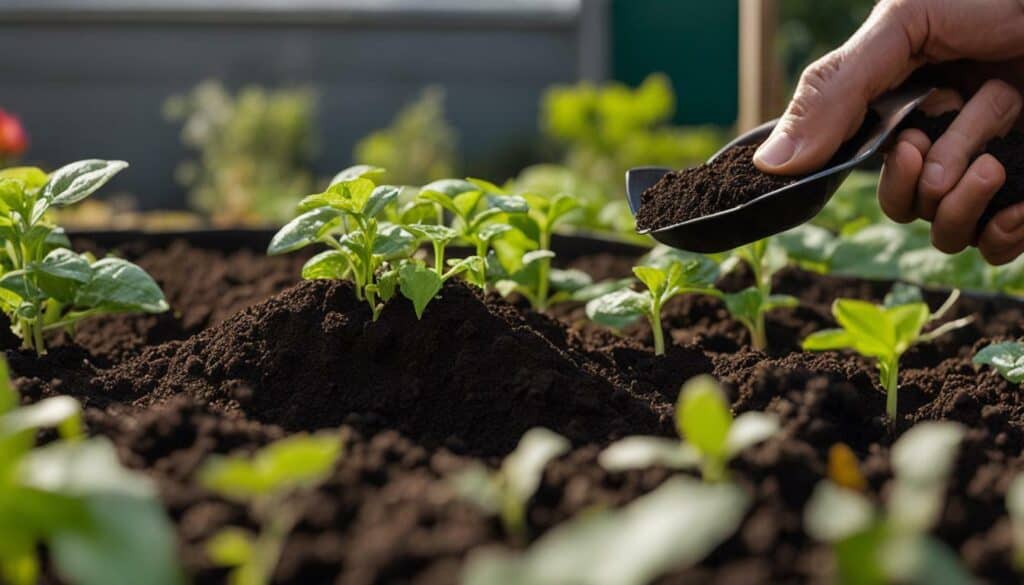
Selecting Vegetables for Square Foot Gardening
The choice of vegetables plays a crucial role in the success of your square foot garden. Here, we will provide recommendations for vegetables that thrive in this gardening method and tips for selecting the right varieties.
Best Vegetables for Square Foot Gardening
When choosing vegetables for your square foot garden, it’s important to consider their growth habits, space requirements, and compatibility with other plants. Here are some vegetables that are well suited for square foot gardening:
| Vegetable | Spacing per Square Foot | Notes |
|---|---|---|
| Leafy greens (lettuce, spinach, kale) | 4 plants | Harvest outer leaves for continuous growth |
| Carrots | 16 plants | Choose shorter varieties for easier harvesting |
| Radishes | 16 plants | Fast-growing and ideal for succession planting |
| Tomatoes | 1 plant | Stake or cage for support, choose determinate varieties for limited space |
| Cucumbers | 2 plants | Use trellis or cage for vertical growth |
| Peppers | 1 plant | Choose compact varieties for smaller spaces |
These are just a few examples, and there are many other vegetables that can thrive in a square foot garden. Consider your family’s preferences and growing conditions when selecting crops.
Tips for Selecting the Right Varieties
When choosing vegetable varieties for your square foot garden, keep the following tips in mind:
- Look for compact or dwarf varieties that are specifically bred for small spaces. These plants are more likely to thrive in the limited area of a square foot garden.
- Consider the maturity time of the plant. Some vegetables, like radishes and lettuce, have a short time to maturity and can be harvested quickly, allowing for succession planting.
- Pay attention to the plant’s sunlight requirements. Make sure you choose varieties that are suitable for the amount of sun your square foot garden receives.
- Research disease resistance. Look for varieties that are resistant to common diseases in your area, as this will increase your chances of a successful harvest.
“Choosing the right vegetables and varieties is key to a successful square foot garden. By selecting plants that are well-suited for small spaces and compatible with each other, you can maximize your garden’s productivity.”
With these tips in mind, you can confidently choose the right vegetables and varieties for your square foot garden. Happy planting!
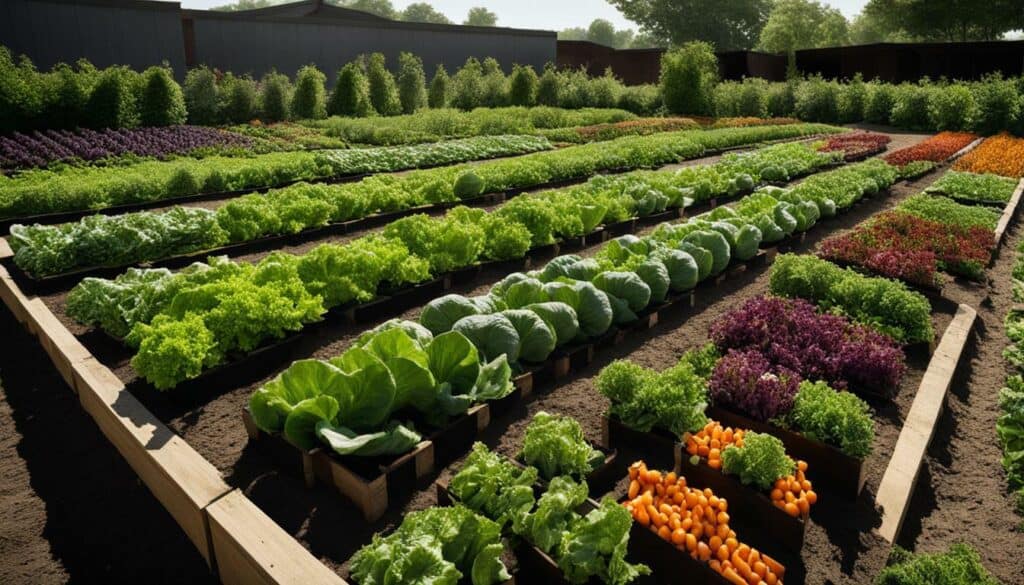
Watering and Maintenance in Square Foot Gardening
Proper watering and maintenance are vital to the health and productivity of your square foot garden. In this section, we will share essential tips for watering, pest control, and general upkeep to ensure your garden thrives.
Watering your Square Foot Garden
One of the most important aspects of square foot gardening is proper watering. Since plants in a square foot garden are planted closer together, they may require more frequent watering than traditional gardens. Here are some tips for watering your square foot garden:
- Water deeply: When watering, make sure the water reaches the roots of the plants. Shallow watering can lead to weak and shallow root systems. Use a soaker hose or drip irrigation system to ensure even and deep watering.
- Water in the morning: Watering in the morning allows the plants to absorb the water and nutrients throughout the day. It also helps prevent disease by allowing the foliage to dry before evening.
- Monitor soil moisture: Check the moisture level of the soil regularly to avoid overwatering or underwatering. Stick your finger about an inch into the soil. If it feels dry, it’s time to water.
- Use mulch: Mulching around your plants helps retain moisture in the soil and reduces weed growth. Apply a layer of organic mulch, such as straw or wood chips, around your plants to conserve water.
Pro tip: Be careful not to overwater your square foot garden. Overwatering can lead to root rot and other issues. Always pay attention to the moisture needs of your plants and adjust your watering schedule accordingly.
Pest Control
Keeping pests at bay is important for the overall health of your square foot garden. Here are some pest control tips:
- Inspect your plants regularly: Check your plants for any signs of pests or damage. Early detection is key to preventing infestations.
- Handpick pests: If you spot any pests on your plants, manually remove them and dispose of them away from your garden.
- Use organic pest control methods: Consider using organic pest control methods, such as neem oil or insecticidal soap, to protect your plants from pests. These options are safer for the environment and for beneficial insects.
- Encourage beneficial insects: Some insects, like ladybugs and lacewings, are natural predators of garden pests. Planting flowers that attract these beneficial insects can help keep pest populations in check.
General Upkeep
In addition to watering and pest control, there are some general upkeep tasks you should regularly perform in your square foot garden:
- Weeding: Keep your garden free of weeds, as they compete with your plants for nutrients and water. Regularly pull out any weeds that appear.
- Pruning and harvesting: Trim back plants as needed to promote healthy growth and to prevent overcrowding. Harvest your vegetables when they are ripe to encourage continuous production.
- Soil maintenance: As the plants in your square foot garden use up nutrients, replenish the soil by adding compost or organic fertilizer. This will help ensure your plants have the necessary nutrients for healthy growth.

“Proper watering and maintenance are vital to the health and productivity of your square foot garden. In this section, we will share essential tips for watering, pest control, and general upkeep to ensure your garden thrives.” – Me, Professional Copywriting Journalist
By following these tips for watering and maintenance, you can ensure that your square foot garden thrives and produces a bountiful harvest. Remember to stay vigilant and address any issues promptly to keep your garden healthy and productive.
Companion Planting in Square Foot Gardening
Companion planting is a valuable technique to implement in your square foot garden. By strategically planting certain vegetables together, you can create a harmonious environment that provides multiple benefits for your plants. Here’s how companion planting can enhance your square foot garden:
Pest Control
One of the key advantages of companion planting is its ability to naturally deter pests. Certain plants have natural repellent properties that can keep common garden pests at bay. For example, planting marigolds alongside your vegetables can help repel aphids, nematodes, and other harmful insects. Similarly, planting onions or garlic can help deter pests like beetles and aphids.
In addition to repelling pests, companion planting can also attract beneficial insects that prey on garden pests. For instance, planting flowers like calendula or alyssum can attract pollinators and predatory insects, such as ladybugs, lacewings, and hoverflies, which feed on aphids and other harmful pests.
Improving Nutrient Uptake
Companion planting can also enhance the nutrient uptake of your plants. Some plants have deep root systems that can help bring up nutrients from deeper soil layers, while others have shallow roots that are efficient at absorbing surface nutrients. By planting these complementary plants together, you can create a more diverse and efficient root system that maximizes nutrient absorption.
For example, planting nitrogen-fixing legumes like peas or beans alongside leafy greens can improve the nitrogen levels in the soil, benefiting the entire garden. Additionally, planting herbs like basil or dill near tomatoes can improve their flavor and growth.
Enhancing Overall Garden Health
Companion planting can contribute to the overall health of your square foot garden by creating a balanced ecosystem. The diverse mix of plants can help prevent the buildup of pests and diseases that can occur in monoculture gardens. By creating a biodiverse environment, you can promote natural pest control, improve soil fertility, and reduce the risk of plant diseases.
Companion planting is like creating a garden community, where each plant supports and benefits the others.
Example Companion Planting Combinations
To give you a head start, here are a few popular companion planting combinations for your square foot garden:
| Companion Plants | Benefits |
|---|---|
| Tomatoes and basil | Basil improves tomato flavor, while tomatoes repel pests that affect basil. |
| Carrots and onions | Onions repel carrot flies, while carrots help loosen the soil for onions. |
| Lettuce and radishes | Radishes repel lettuce pests, while lettuce provides shade for radish roots. |
Feel free to experiment with different companion planting combinations based on your specific gardening needs and preferences. Remember to consider factors like plant compatibility, growth habits, and sunlight requirements when planning your companion plantings.
Companion planting in your square foot garden can lead to healthier, more productive plants and a more vibrant garden ecosystem. By implementing this technique, you can create a sustainable and harmonious environment that benefits both you and your plants.
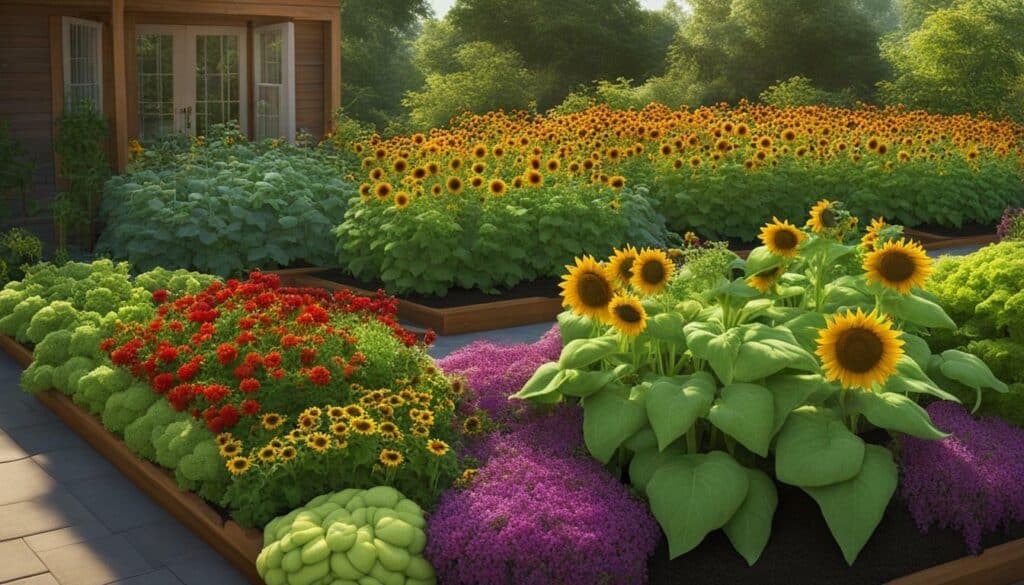
With companion planting, your square foot garden will flourish with an abundance of healthy vegetables and vibrant flowers. So start planning your companion planting combinations and enjoy the benefits of this time-tested technique!
Extending the Growing Season in Square Foot Gardening
With a few simple techniques, you can extend your growing season in square foot gardening and enjoy fresh produce for a longer period of time. By utilizing cold frames and row covers, you can protect your plants from the elements and continue growing even when the weather starts to cool down.
1. Cold Frames
A cold frame is a simple and effective way to create a microclimate for your plants, providing them with the warmth and protection they need during colder months. It is essentially a transparent box, usually made of wood or metal, with a transparent cover, such as glass or plastic.
To create a cold frame, you can simply use a wooden frame with a hinged lid that can be opened or closed as needed. Place the frame over your square foot garden bed, making sure it is securely in place. The transparent cover will allow sunlight to enter, creating a greenhouse effect and trapping heat inside.
During the day, you can open the lid to allow for ventilation and prevent overheating. At night, close the lid to keep the warmth inside. Cold frames are especially useful for cool-season crops like lettuce, spinach, and kale.
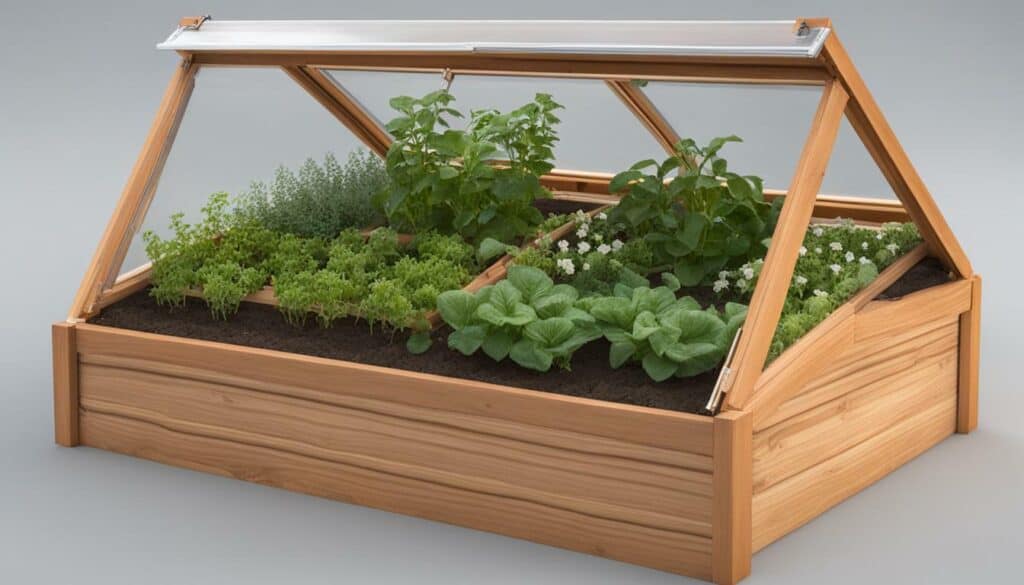
2. Row Covers
Row covers are lightweight fabrics or nets that can be draped over your plants to provide protection from cold temperatures, wind, and pests. They allow sunlight, water, and air to pass through while creating a barrier that helps retain heat.
To use row covers, simply drape them over your square foot garden bed, securing the edges with weights or stakes to prevent them from blowing away. Make sure the covers are not touching the plants directly, as this can cause damage. Leave enough slack so that the plants have room to grow.
Row covers come in different thicknesses, providing varying degrees of insulation. For early-season planting, you can use lightweight covers that allow more sunlight to reach the plants. As the weather gets colder, you can switch to heavier covers to provide more protection.
3. Succession Planting
Succession planting is a technique where you stagger your plantings to ensure a continuous harvest throughout the growing season. By planting crops at different times, you can extend your harvest and enjoy fresh produce for longer.
In square foot gardening, you can easily implement succession planting by replanting squares as soon as the previous crop is harvested. This way, you’ll always have new plants growing and ready for harvest.
4. Choosing Cold-Tolerant Crops
Another way to extend your growing season in square foot gardening is by choosing cold-tolerant crops that can withstand cooler temperatures. These crops can be planted earlier in the season and continue to grow even as the weather cools down.
Some cold-tolerant crops that are suitable for square foot gardening include lettuce, spinach, kale, radishes, carrots, and peas. These crops can handle frost and colder temperatures, allowing you to enjoy fresh produce well into the fall or even winter months.
By implementing these techniques, you can make the most of your square foot garden and continue growing and harvesting fresh produce for an extended period of time. Whether you use cold frames, row covers, succession planting, or choose cold-tolerant crops, you’ll be able to enjoy the fruits of your labor long after the traditional growing season has ended.
Troubleshooting Common Issues in Square Foot Gardening
Despite its many benefits, square foot gardening may encounter some common issues. In this section, we will address these problems and provide effective solutions to keep your garden thriving.
1. Nutrient Deficiencies
Nutrient deficiencies can occur in square foot gardening when the soil is not properly balanced. To prevent this issue, regularly test the soil for nutrient levels and adjust accordingly. Adding compost or organic fertilizer can help replenish nutrients. Additionally, consider rotating your crops each season to prevent nutrient depletion in specific areas of the garden.
2. Pest Infestations
Pests can be a challenge in square foot gardening, but there are several strategies you can employ to combat them. One effective method is companion planting, where certain plants are grown together to repel pests. Additionally, using organic pest control methods such as neem oil or insecticidal soap can help protect your plants. Regularly inspect your garden for signs of pests and take action as soon as possible.
3. Overwatering
Overwatering is a common mistake in square foot gardening. It’s important to remember that the smaller planting areas require less water than traditional gardens. It’s better to water deeply and infrequently rather than constantly keeping the soil wet. Use a moisture meter or stick your finger into the soil to determine if it’s time to water. Proper drainage is also essential, so ensure that your raised beds have adequate drainage holes.
4. Weeds
Keeping weeds at bay is crucial in square foot gardening to prevent competition for nutrients and space. Regularly inspect your garden for weeds and remove them promptly. Mulching can help suppress weed growth, but be sure to use organic materials that won’t introduce weed seeds into your garden. Hand pulling is often the most effective method for small-scale weed control.
5. Disease Management
Diseases can affect plants in square foot gardening, but proper preventative measures can minimize their impact. Avoid overhead watering, as this can spread diseases. Provide adequate spacing between plants to promote air circulation. Regularly inspect your plants for signs of disease and promptly remove any infected plants to prevent the spread.
| Common Issues | Solutions |
|---|---|
| Nutrient deficiencies | – Regularly test soil and adjust nutrient levels – Add compost or organic fertilizer – Rotate crops |
| Pest infestations | – Use companion planting – Employ organic pest control methods – Regularly inspect and take action |
| Overwatering | – Water deeply and infrequently – Use a moisture meter or finger test – Ensure proper drainage |
| Weeds | – Regularly inspect and remove weeds – Mulch with organic materials – Hand pulling |
| Disease management | – Avoid overhead watering – Provide adequate spacing – Promptly remove infected plants |
“Proper care and attention to common issues in square foot gardening will help ensure a successful and thriving garden.”
By following these troubleshooting tips, you can overcome common issues in square foot gardening and enjoy a bountiful harvest. Remember that each garden is unique, so it’s important to observe and adapt accordingly. With patience and perseverance, your square foot garden will flourish.
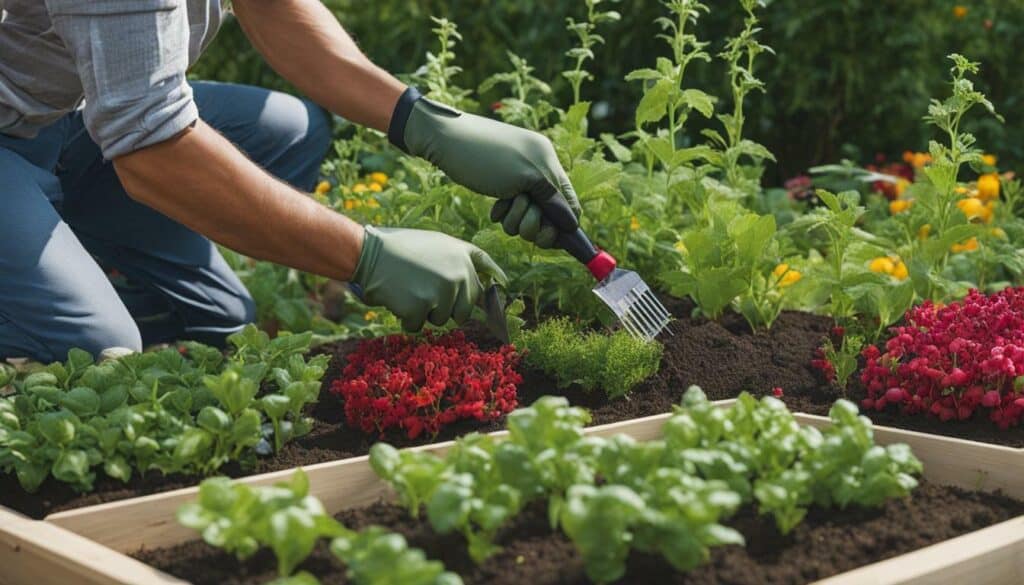
Harvesting and Enjoying the Fruits of Your Labor
The moment you’ve been waiting for has arrived – it’s time to harvest the fruits of your square foot garden! After all your hard work and nurturing, it’s exciting to see your vegetables ready for picking. Here are some best practices for harvesting your vegetables and a few creative recipe ideas to savor the flavors of your garden.
Harvesting Tips
Proper timing is crucial when it comes to harvesting your produce. Here are some general guidelines to ensure you pick your vegetables at the peak of ripeness:
- Observe the visual cues: Look for bright colors, firm texture, and mature size.
- Refer to seed packets or gardening resources for specific harvesting instructions for each vegetable.
- Use clean gardening shears or a sharp knife to harvest, and avoid damaging the plant.
- Harvest in the morning when the plant is hydrated and the flavors are more concentrated.
- Regularly check your garden for ripe produce, as some vegetables can quickly become overripe.
Remember, harvesting is an ongoing process, and it’s best to continuously harvest your plants to encourage further growth and prevent overcrowding.
Recipe Ideas
Now that you have a bountiful harvest, it’s time to enjoy the delicious flavors of your square foot garden. Here are a few recipe ideas to inspire you:
“Fresh Garden Salad: Combine your freshly harvested lettuce, cucumbers, and cherry tomatoes for a refreshing salad. Drizzle with olive oil and your favorite dressing for a burst of flavor.”
“Roasted Root Vegetables: Toss your harvested carrots, beets, and potatoes with olive oil, salt, and herbs. Roast in the oven until tender and enjoy the earthy sweetness.”
“Zucchini Bread: Put your zucchini to good use by baking a delicious loaf of zucchini bread. Add in some nuts or chocolate chips for an extra indulgence.”
These recipe ideas are just a starting point – feel free to get creative and experiment with the flavors of your harvest. Whether you’re enjoying your vegetables raw, cooked, or preserved, the satisfaction of eating your own homegrown produce is truly rewarding.
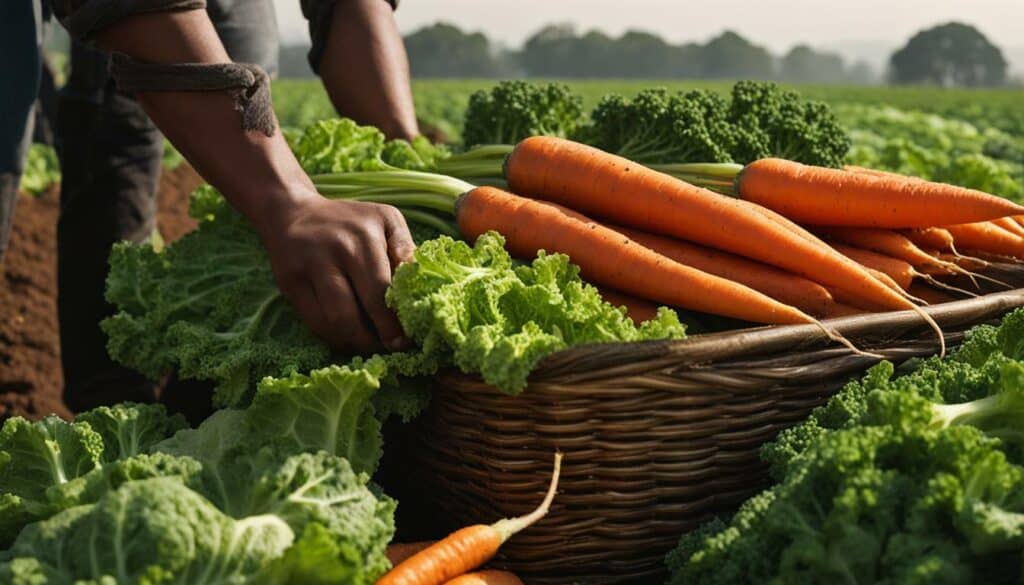
Remember, each season brings new opportunities to refine your square foot gardening skills. With practice and experience, you’ll become more confident in your ability to grow and harvest a variety of vegetables. So, enjoy the process, savor the flavors, and continue to nurture your square foot garden for years to come.
Square foot gardening is a rewarding and efficient way to grow your own food, even in limited space.
By following the basics outlined in this guide, you can start your square foot garden with confidence and enjoy the abundant harvests that await you.
What is Square Foot Gardening?
Square foot gardening is a method of gardening that involves dividing the growing area into small, manageable squares. Each square is then planted with a specific number of plants, depending on their size. This method allows for high yields in a small space and eliminates the need for traditional row-spacing.
Benefits of Square Foot Gardening
There are several benefits to implementing square foot gardening in your backyard. First and foremost, it allows you to grow a large amount of food in a small area. This is especially valuable for those with limited space or urban gardens. Additionally, square foot gardening reduces the amount of weeding and maintenance required, as plants are spaced closely together, leaving little room for weeds to grow.
Getting Started with Square Foot Gardening
To get started with square foot gardening, you’ll need to plan and design your garden layout. This involves determining the size and location of your garden beds, as well as deciding which vegetables you want to grow. You’ll also need to prepare the soil by adding compost and other organic matter to improve its fertility and drainage.
Choosing the Right Soil for Square Foot Gardening
The quality of the soil is crucial for the success of your square foot garden. It’s important to select a soil mix that is well-draining and rich in nutrients. This can be achieved by combining equal parts of compost, vermiculite, and peat moss. Avoid using regular garden soil, as it may be too compacted and lacking in essential nutrients.
Selecting Vegetables for Square Foot Gardening
When choosing vegetables for your square foot garden, consider the size and spacing requirements of each plant. Opt for compact varieties that can be planted closely together. Some popular choices for square foot gardening include lettuce, radishes, carrots, and herbs. Be sure to also consider the sun and shade requirements of each plant when deciding on their placement in your garden.
Watering and Maintenance in Square Foot Gardening
Proper watering and maintenance are essential for the success of your square foot garden. Water your plants deeply and regularly, making sure to keep the soil evenly moist. Mulching can help reduce water evaporation and suppress weed growth. Additionally, regular weeding and pest management are necessary to prevent competition and damage to your crops.
Companion Planting in Square Foot Gardening
Companion planting is the practice of planting different plants together to maximize their growth and deter pests. In square foot gardening, companion planting can help control pests and enhance the overall health of your garden. Some common companion plants include marigolds, basil, and nasturtiums. Research the specific companion planting arrangements that work well for the vegetables you have chosen to grow.
Extending the Growing Season in Square Foot Gardening
There are several strategies you can use to extend the growing season in your square foot garden. One method is to use cold frames or row covers to protect your plants from frost and extend their growing period. Another option is to plant cold-tolerant vegetables that can withstand cooler temperatures. Additionally, using mulch and proper watering techniques can help maintain soil warmth and encourage continuous growth.
Troubleshooting Common Issues in Square Foot Gardening
While square foot gardening is generally a low-maintenance method, there may be some challenges that arise. Common issues include nutrient deficiencies, pest infestations, and diseases. It’s important to regularly monitor your plants for signs of trouble and take appropriate action. This may involve adjusting your watering and fertilizing practices or implementing organic pest control methods.
Harvesting and Enjoying the Fruits of Your Labor
When it’s time to harvest your square foot garden, be sure to pick your vegetables at their peak ripeness for the best flavor and nutritional value. Enjoy your harvest by incorporating the fresh produce into delicious recipes. From salads to stir-fries, there are endless possibilities for enjoying the fruits of your labor.
Conclusion
Square foot gardening offers a practical and efficient way to grow your own food, even with limited space. By following the basic principles of square foot gardening, you can create a beautiful and productive garden that will provide you with fresh produce throughout the growing season. So why wait? Start your square foot gardening journey today and reap the rewards of growing your own food.
FAQ
Q: What is square foot gardening?
A: Square foot gardening is a gardening method that involves dividing a garden bed into square foot sections and planting different crops in each section. It maximizes garden space and increases yields.
Q: What are the benefits of square foot gardening?
A: Square foot gardening allows you to grow more produce in a smaller space, reduces maintenance, and minimizes weeds. It is also great for beginners and those with limited gardening experience.
Q: How do I get started with square foot gardening?
A: To get started with square foot gardening, you need to plan your garden layout, build or purchase raised beds, prepare the soil, and choose the right vegetables to plant. It is important to follow the square foot gardening method for optimal results.
Q: What soil should I use for square foot gardening?
A: It is recommended to use a high-quality soil mix for square foot gardening, such as a blend of compost, peat moss, and vermiculite. This provides the right balance of nutrients and moisture retention for healthy plant growth.
Q: How often should I water my square foot garden?
A: The frequency of watering your square foot garden will depend on various factors, including the weather, soil moisture, and the specific needs of your plants. It is important to monitor the soil moisture and water when necessary to keep the plants hydrated.
Q: How do I address pest issues in square foot gardening?
A: There are various organic pest control methods that can be used in square foot gardening, such as companion planting, natural pest deterrents, and manual removal of pests. Regular inspection and monitoring of your garden can help catch pest issues early on.
Q: How can I extend the growing season in square foot gardening?
A: To extend the growing season in square foot gardening, you can use techniques such as using cold frames or row covers to protect plants from frost and provide additional warmth. This allows you to start planting earlier in the spring and continue harvesting later into the fall.
Q: What are common issues that may arise in square foot gardening?
A: Common issues in square foot gardening include nutrient deficiencies, pest infestations, and plant diseases. It is important to regularly monitor your garden and take appropriate measures to address these issues, such as adding organic fertilizers, using natural pest control methods, and practicing good garden hygiene.
Q: How do I harvest and use the produce from my square foot garden?
A: Harvesting in square foot gardening involves picking the ripe vegetables and herbs as they become ready for consumption. You can enjoy the fresh produce in various recipes, preserve them for later use, or share them with friends and family.
What Are the Basics of Square Foot Gardening for Beginners?
Square foot gardening is a beginner-friendly master gardening technique that allows beginners to grow a variety of plants in a small space. The basics include dividing the garden plot into square foot sections, using good soil mix, and planting according to the recommended spacing. With these beginner-friendly master gardening basics, anyone can start and enjoy a bountiful garden.

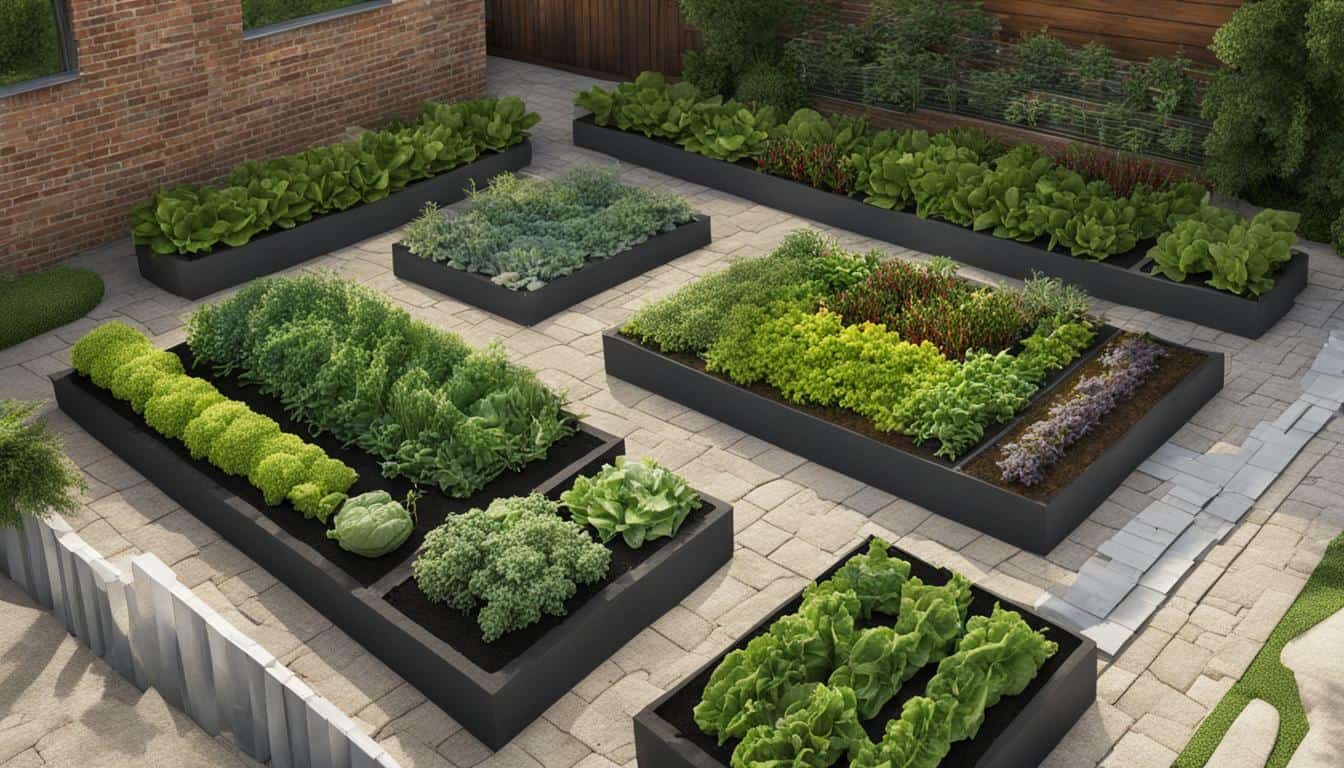



Leave a Reply